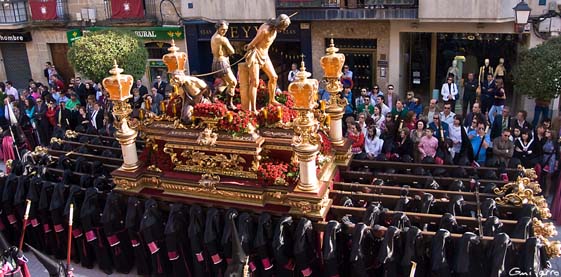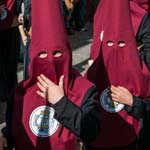Easter
Easter is the annual Christian commemoration of the passion, death and resurrection of Jesus of Nazareth. It is a period of intense liturgical activity in the different Christian confessions, which runs from Sunday to Sunday (or Friday to the next Sunday in some cases), and happens right after Lent. This holiday period is known in other countries as "Spring Break".
In Spain, Easter (Semana Santa in Spanish), is celebrated with the exit to the streets of manifestations of faith, called processions, in which religious images are displayed and paraded through town by a brotherhood. These religious images are carried on floats (called pasos in Spanish), carried by members of the brotherhoods. They represent images of Christ's passion, images of the Virgin Mary, or of saints. There are also the penitents, members of the brotherhoods that carry the images or play drum music, covered in robes and with a conical hat on their head, from which drops a cloth mask to protect their anonymity. This is the traditional costume of the penitents, and each brotherhood has a distinctive color and saying that differentiates them from one another.

Origin
The origin of this celebration is as old as Christianity itself, for as early as 325 AD, in the First Council of Nicaea, there was an attempt to establish a date that would respond to the celebrations that were common amongst the first Christians, who tried to evoke the last week of Jesus of Nazareth. After some conflict with the church of Alexandria, the dates for the celebration were finally established in 525 AD by St. Dionysius Exiguus, who unified the calculation.
Cities
There are more than 50 cities in Spain that celebrate Easter with a tremendous display of enthusiasm, 16 of which have received the recognition of Fiestas of International Tourist Interest. We will just describe the peculiarities of 4 of the most well-known, impressive or eye-catching celebrations: Seville, Granada, Málaga, Salamanca and Toledo.
Seville
Together with the Feria de Abril (April Fair), Easter is the big celebration of Seville in April. The basis of the celebration is, as in all other Spanish cities, a series of religious processions taking place every day for a whole week (from Palm Sunday to Easter Sunday). The devotional feeling is especially strong in Seville, and it manifests in some peculiarities that other Easter celebrations don't have, like the saeta. This is a religious chant, usually improvised and without accompaniment, sung to the images in procession from a house's balcony. It is a very special example of folklore, since this musical exhibition can be rooted back to the Arab and Moorish influence, and is deeply connected with cante jondo, the form of singing usually found in flamenco.
Granada

The Easter in Granada is also very deeply rooted, and is lived with great joy and devotion by the locals. There are two peculiarities in Granada, which are the Gipsy Procession, on Holy Wednesday, and the Procession of Silence, on Holy Thursday. The former is a very lively and different from the more solemn "official" processions. In the Gipsy Procession, which runs through the Albaicin hills, bonfires are lit all along the way, and it stops every now and then for the singing of the saetas, usually performed by the local gipsies. The Procession of Silence is a very impressive event, for the streets lights along the route are turned off, and the whole procession is executed in complete silence, which is definitely quite a breathtaking experience, independently of one's religious feelings.
Málaga
The particularities of the Easter celebration in Malaga are basically two: the size of the floats, and the procession itself, in which the security forces of the State take part. To begin with, the floats do not receive the name pasos, as is common in all Easter processions around Spain, but tronos (thrones). They are usually larger in size, what also has a n influence on the way they are lifted and carried around town. As we said earlier, a very strange custom is that these thrones are usually escorted by policemen or even army officers, in a representation of the lifelong associations between the church and the State in Spain.
Salamanca
Salamanca stands out in the celebrations of the Easter specially because the value and high artistic interest of the floats that are paraded. The oldest images date back to the XV century, and are very much looked after and preserved in the best condition by the members of the different brotherhoods. Also, being Salamanca such a University town, there is a procession on Holy Tuesday called the University Procession, which is organized and carried out by the University Brotherhood. There is even a typical meal, a special sour salad called Limones, which is eaten on Holy Thursday and Friday.
Toledo
The basic curiosity of Toledo's Easter festivities is that, instead of lasting one week like in every other Spanish town, the celebrations here start eight days before Friday of Sorrows (Viernes de Dolores, the day when it all starts in all the other sities). As you can imagine, Toledo is a very devotional city and the two weeks of celebrations are lived in great awe and solemnity, a very Castilian attribute.
Curiosities

But not all the celebrations in the Spanish Easter are of the same nature as the ones we have been describing. Some cities present a series of curious events, more or less attached to the religious celebration, that happen around the main devotional processions. We are going to describe just some of the most interesting, bizarre, or even satyrical celebrations that happen around this time, events for which you should make sure to keep your eyes -and ears- wide open.
Calanda's Drums
As Luis Buñuel described in a very poetic fashion in his memories, Calanda (a 3,500 people village on the mountainside of Aragon) turns into a thunderous sounding venue on the morning of Holy Friday. At exactly 12 o'clock, when the first ring of the bells announce the hour, starts a deafening sound from the thousands of drums congregated at the town's square. This goes on for about two hours, when there is a march around the village that includes a representation of duel between two Roman legionaries, to all be over by 5 in the afternoon.
Vergés
One of the most intriguing and atypical celebrations of Easter take splace in Vergés, a small Catalonian village: there, on Holy Thursday, there is a staged representation of the passion of Jesus of Nazareth. This is a very colourful and spectacular representation, used in ancient times to explain the religious messages to the illiterate crowds. But what stands out is one of the parts of the play: the only remaining example of a Dance of Death, a reminiscent of those macabre dances associated with the Black Death in the XIV and XVII centuries. This event tries to portray the passing of time, and the inevitability of death, which comes to all living things.
Folía
This celebration works as a reminder of the happenings of a certain Holy Tuesday when, according to the tradition, an image of the Virgin appeared i the port of the small town of San Vicente de la Barquera, in Cantabria, on a boat with no crew, and no rows. To commemorate this event, the people of San Vicente organize a huge festivity to take the Virgin back to her sanctuary by sea, in which the whole town takes part. All along the way there are dances and singing, and none of the sailors in town work on that day.
Genarín
Probably the weirdest of the Easter celebrations happens in the northern Spanish city of León. There, on the night of Holy Thursday, a procession takes place commemorating the death of a drunkard furrier called Genaro, hit by the first garbage pickup truck operating in town in 1929. It is a very pagan celebration surrounded by heavy drinking and offerings to the furrier on top of the city's medieval walls. Even though it was banned during Franco's dictatorship, with the democratic era its fame and tourist impact has kept growing bigger.

 The highest and purest expression of religious devotion and traditional religious artwork, Easter in Spain is a time for spirituality that will surely impress the visitor.
The highest and purest expression of religious devotion and traditional religious artwork, Easter in Spain is a time for spirituality that will surely impress the visitor. 